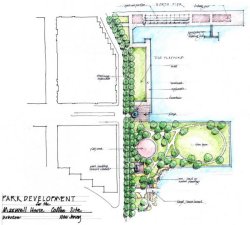
(March 2002)
Potentially, Maxwell House Park could be the jewel in the crown of Hoboken’s string of waterfront parks. In a unique land conservation arrangement orchestrated by the Fund for a Better Waterfront (FBW), the owners of the former Maxwell House Coffee plant have offered to donate one-third of their 14-acre site for a public, waterfront park. After a year of negotiations, FBW has come close to completing an agreement with the owners that they invest an estimated $9.5 million to construct a 5-acre park whose quality would be unrivaled on the New Jersey side of the Hudson River. The fate of this deal, however, is unclear as this development project winds its way through a tortuous approval process. If the project is approved, Maxwell House Park would secure one of just three remaining privately owned, undeveloped parcels, bringing Hoboken a step closer to completing the continuous waterfront park first proposed by FBW twelve years ago.
As part of negotiations, FBW’s planner, Craig Whitaker, teamed up with landscape architect, John Imbiano to design a park that maximizes the amount of open space that would be available to the public. The northern pier which juts 486 feet into the Hudson River is designed as a fishing pier. The remainder of the park is comprised of generous amounts of greenspace. Similar to the plantings at Hoboken’s south waterfront, a double row of London Plane trees shades the Hudson River Waterfront Walkway parallel to Sinatra Drive North. Air-entrained soil, also used so successfully at the south waterfront, would also be included for all planted areas in order to help the grass and trees to flourish. (See Roots over the River)
The 3-acre earthen peninsula is given a hard-edge to maximize the usable space. It consists of an open lawn with a circular path and generous plantings of trees. Maxwell House Park will preserve Hoboken’s only natural beach, a cove located just south of this peninsula. This beach is one of the few places along Hoboken’s riverfront where one can walk right down to the water’s edge. This beach area will be planted with natural species and also provide for a canoe and kayak launch.
FBW hired Andrew Strauss, formerly of the Trust for Public Land, to work out the details of the land transaction that would qualify as a charitable contribution with the IRS. Mr. Strauss worked with attorneys for the property owners to draft several legal documents, one a deed of conservation easement for the parkland and the other an option to purchase that would effect the land transfer. The owners, at this point, have backed off from finalizing this arrangement and are expressing an interest in donating the land to the City of Hoboken rather than a nonprofit conservation organization. The fate of FBW’s park design is also now uncertain.
Two years ago, local developers Daniel Gans and George Vallone unveiled their original proposal for a 1.4 million square foot development sprawling over the entire 14 acre site. 350,000 square feet of luxury housing would have been included on the pier, a platform and an earthen peninsula. FBW and other civic organizations objected to this proposal because the development at the water’s edge would have privatized the piers and platform and obstructed the completion of the proposed continuous waterfront park. After a number of months of discussions between community groups and the developers, the property owners agreed to confine the private portion of their project to four upland blocks and preserve the five acres east of an extended Sinatra Drive North as parkland.
But the new project, which requires no zoning variances, has come under increasing scrutiny from the public as sentiment against any new development projects in Hoboken has intensified. The Maxwell House development application is now in its eighth month before Hoboken Planning Board. Attorney James Segreto is representing several local business interests before the Board in opposition to the Maxwell House project. The new administration of Mayor David Roberts is publicly supporting an alternative proposal being pushed by the President of Stevens Institute of Technology that returns to the previously defeated idea of building on the pier and peninsula.
Unlike the Stevens’ proposal, the current development project provides a means for the long-term maintenance of the park at no cost to taxpayers. The residential and commercial units that are part of this development would cover the maintenance, estimated to be $300,000 annually plus $140,000 per year to cover long-term capital improvements. Under the FBW deal, four acres of the waterfront park would be built within two years after approvals are obtained.
If Maxwell House Park becomes a reality, this project would be unique. There are no other land conservation arrangements of this type that have been carried out in a urban, waterfront setting, especially on such a highly valued piece of real estate. Although land conservation deals are becoming increasingly popular, they tend to be consummated in rural and wilderness areas. Maxwell House Park would also be unusual for the partnership that was forged between developers and a civic organization. Typically, civic organizations have been at loggerheads with private developers who have sought to claim as much land as possible at the water’s edge for their private use.
FBW Editorial

